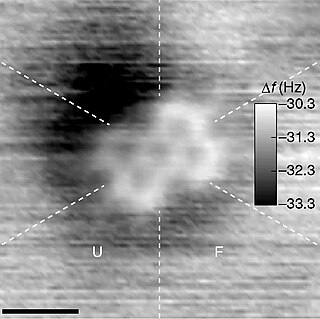The molecular formula C10H6O2 (molar mass: 158.15 g/mol, exact mass: 158.0368 u) may refer to:
The molecular formula C10H6O2 (molar mass: 158.15 g/mol, exact mass: 158.0368 u) may refer to:
In chemistry, a chemical formula is a way of presenting information about the chemical proportions of atoms that constitute a particular chemical compound or molecule, using chemical element symbols, numbers, and sometimes also other symbols, such as parentheses, dashes, brackets, commas and plus (+) and minus (−) signs. These are limited to a single typographic line of symbols, which may include subscripts and superscripts. A chemical formula is not a chemical name, and it contains no words. Although a chemical formula may imply certain simple chemical structures, it is not the same as a full chemical structural formula. Chemical formulae can fully specify the structure of only the simplest of molecules and chemical substances, and are generally more limited in power than chemical names and structural formulae.

A molecule is a group of two or more atoms held together by attractive forces known as chemical bonds; depending on context, the term may or may not include ions which satisfy this criterion. In quantum physics, organic chemistry, and biochemistry, the distinction from ions is dropped and molecule is often used when referring to polyatomic ions.
In chemistry, the molar mass of a chemical compound is defined as the mass of a sample of that compound divided by the amount of substance which is the number of moles in that sample, measured in moles. The molar mass is a bulk, not molecular, property of a substance. The molar mass is an average of many instances of the compound, which often vary in mass due to the presence of isotopes. Most commonly, the molar mass is computed from the standard atomic weights and is thus a terrestrial average and a function of the relative abundance of the isotopes of the constituent atoms on Earth. The molar mass is appropriate for converting between the mass of a substance and the amount of a substance for bulk quantities.

1,2-Naphthoquinone or ortho-naphthoquinone is a polycyclic aromatic organic compound with formula C
10H
6O
2. This yellow solid is prepared by oxidation of 1-amino-2-hydroxynaphthalene with ferric chloride.

Menadione is a natural organic compound with the formula C6H4(CO)2C2H(CH3). It is an analog of 1,4-naphthoquinone with a methyl group in the 2-position. It is sometimes called vitamin K3. Use is allowed as a nutritional supplement in animal feed because of its vitamin K activity.
The molecular formula C6H8O6 (molar mass: 176.124 g/mol) may be:
The molecular formula C3H2ClF5O (molar mass: 184.49 g/mol, exact mass: 183.9714 u) may refer to:
The molecular formula C5H12O (molar mass: 88.15 g/mol, exact mass: 88.088815) may refer to:
The molecular formula C6H6O4 (molar mass : 142.10 g/mol, exact mass : 142.026608 u) may refer to:
The molecular formula C14H12O2 (molar mass : 212.24 g/mol, exact mass: 212.08373 u) may refer to:
The molecular formula C11H8O3 (molar mass: 188.18 g/mol, exact mass: 188.0473 u) may refer to:
The molecular formula C10H22O (molar mass: 158.28 g/mol, exact mass: 158.1671 u) may refer to:
The molecular formula C9H18O2 (molar mass: 158.24 g/mol) may refer to:
The molecular formula C10H6O3 (molar mass: 174.15 g/mol, exact mass: 174.0317 u) may refer to:
The molecular formula C15H14O7 may refer to:
The molecular formula C15H10Cl2N2O2 (molar mass: 321.158 g/mol) may refer to:
The molecular formula C10H10N2 (molar mass: 158.20 g/mol, exact mass: 158.0844 u) may refer to:
The molecular formula C5H6N2O4 (molar mass: 158.11 g/mol, exact mass: 158.0328 u) may refer to:

Spinochrome E, 2,3,5,6,7,8-Hexahydroxy-1,4-naphthalenedione, also called hexahydroxynaphthoquinone is a polyhydroxylated 1,4-naphthoquinones, pigments found in sea urchin shell ("test"), spine, gonads, coelomic fluid, and eggs, of sea urchin commonly known as spinochromes. These natural phenolic compounds are quinones that are known to have pharmacological properties. The several hydroxyl groups are appropriate for free-radical scavenging, which diminishes ROS and prevents redox imbalance. Mechanisms are described such as scavenging of reactive oxygen species (ROS), interaction with lipid peroxide radicals, chelation of metal ions, inhibition of lipid peroxidation and regulation of the cell redox potential.
A hydroxynaphthoquinone is any of several organic compounds that can be viewed as derivatives of a naphthoquinone through replacement of one hydrogen atom (H) by a hydroxyl group (-OH).